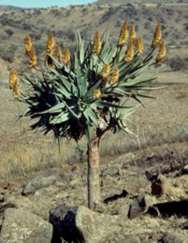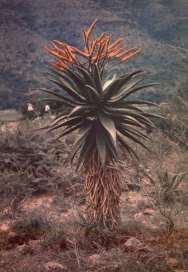Aloe marlothii
Aloe marlothii A.Berger
Family: Asphodelaceae
Common names: mountain aloe, flat-flowered aloe (Eng.); bergalwyn (Afr.); inhlaba, umhlaba (Zulu)
Introduction
Aloe marlothii is a striking, robust, large, single-stemmed aloe with a majestic presence. The mountain aloe is without doubt one of southern Africa's most rewarding aloes to grow and adds an interesting slant to aloe culture.

Description
Description
Aloe marlothii is a large, perennial, succulent, single-stemmed aloe, usually 2-4 m tall (occasionally up to 6 m), with old dried leaves remaining on the stem below the upper living leaves. Leaves are large, broad and succulent, light green to greyish green to blue-green, up to 1500 x 250 mm, having a broad base tapering to a sharp point, covered with spines on upper and lower surfaces and maroon- coloured teeth with orange tips along leaf margins.

Flowers are held on racemes on a branched candelabra-shaped inflorescence, having up to 30 racemes (single spikes covered with individual flowers). Flower colour varies from the typical orange-red to yellow or bright red and may be present between May and September. The distinguishing character lies in the slanted inflorescences. They are usually almost horizontal but may be almost vertical in some forms. For an impressive illustration of A. marlothii to scale see Reynolds (1982: 481).

Conservation Status
Status
Not threatened.
Distribution and habitat
Distribution description
Aloe marlothii occurs from the North-West Province, Gauteng, Limpopo, Mpumulanga, Swaziland, Zimbabwe, Botswana and Mozambique to KwaZulu-Natal north of Durban, from sea level to 1 600 m.

It is found mainly in bushveld vegetation along mountainous areas, rocky terrain and slopes where temperatures are warmer and frost infrequent. Mountain ranges of the Drakensburg, Lebombo, Zoutpansberg and Waterberg have large populations of the species. It is thus not surprising that the common names bergalwyn or mountain aloe have been applied. At high altitudes however, the species does not occur in very cold areas, but the species does exhibit tolerance to frost.

Derivation of name and historical aspects
History
The genus Aloe stems from the Greek aloe, pertaining to the product of the dried juice from aloe leaves, probably derived from the Semetic (alloeh), Hebrew (allal) and Sanskrit words. The specific name marlothii is named after the well-known botanist H.W. Rudolf Marloth. There are some 500 species within the genus, of which 135 occur in southern Africa and some 125 in South Africa alone.
Historical notes on the clustering of Aloe marlothii associated with African Iron Age archeological sites on the Pietersburg Plateau
On the Polokwane (formerly Pietersburg) Plateau there is somewhat of an anomaly in the distribution of Aloe marlothii in terms of climatic and ecological preferences. Here dense stands of large 80-100 year-old plants occur on colder, flatter and more gradually sloped, frost frequent areas where they would usually be absent. The explanation for this is intriguing since the stands occur on archaeological sites where the African Iron Age Ndebele village ruins are. The villages date from 1650 to 1880 when the Ndebele occupied the area. A. marlothii occurs at the ruins along the ashy deposits and stone-walled sites where the soils are enriched and the plants are thought to have germinated shortly after the Boer conquest of the Ndebele in 1855. The seeds were brought to the Ndebele villages from plant material they used for a variety of uses such as: using the spiny leaves to scrape hides to prepare women's dresses, using ash from dried leaves for an additive to snuff, eating nectar from the flowers, leaf decoctions to treat roundworm and tapeworm and fresh leaf sap used on women's breasts to wean babies. It is believed that seeds accumulated at the sites this way and that large-scale establishment of A. marlothii took place 20 to 30 years after the sites were abandoned in 1855. Thus large specimens may be up to 110 years old and can be viewed at the Maxonwa Ndebele archaeological site.
Ecology
Ecology
Aloe marlothii is a succulent and is therefore well suited to withstand periods of drought, owing to reserves of water stored in the leaves and stem. The thorns on the leaves and very rough, hard, dried leaves along the stem act as a defence against browsing animals. In times of extreme drought, kudu have been observed browsing the leaves despite the plants defences and may denude the leaves of the plant entirely. If conditions are favourable, plants recover within six months. Another defence against browsing is the eventual height obtained by A. marlothii to escape browsing animals. By growing out of reach of browsers the species has a greater chance of surviving drought.

The flowers of A. marlothii are rich in nectar and provide an important source of energy for sunbirds. The seeds are thin and papery and are dispersed in gusts of winds and vortexes. Seeds are also dispersed by people who use the plant and through garden plants bordering wild areas.
Uses
Use
Leaf and root decoctions are used by the Zulus for roundworm infestations and by other cultures for stomach problems and horse sickness.

Growing Aloe marlothii
Grow
Aloe marlothii will grow easily and with very little care in most South African gardens and is recommended for gardens where the species occurs naturally. Bear in mind this is a summer rainfall species and therefore naturally thrives under warm wet summers and warm to cool, dry winters. Thus grown within its natural distribution range, plants may require less water care. In cultivation the species can tolerate additional watering in both summer and winter rainfall gardens and often as a result the species may appear quite different from the natural forms (i.e. leaves lighter green and less thorny). It is not necessary to deprive your specimens of water, only be aware that over-watering will steadily deteriorate their general health. Prerequisites for success include:
- Full sun-choose a warm spot. Rockeries are ideal for capturing extra heat.
- Watering-a sign of over-watering is over-inflated leaves, excessive over-watering will lead to rot. Under-watering results in thin, harder, less green leaves. Compensate accordingly. Water once a week for the first month following planting and reduce watering thereafter. Well-established plants can survive for several months without water. Be sure not to over-water in heavy clay soils.
- Well-drained soil-no strict soil mix needs to be adhered to for planting, however at least one fourth compost should be incorporated into the soil. One quarter river sand and one quarter compost mixed in equal quantities will improve drainage in heavy clay soils. If you are unable to provide your plant with regular watering, and the soil consists of heavy clay, plant directly. This method will however slow or even stunt the growth of the plant and may lead to rot. Bone meal can be added in generous quantities when planting.
- Size-realize this is a large aloe and needs room to grow.
- Position-planted in the correct position the mountain aloe makes a prize specimen. Plants can be used as living pillars along driveways or fences or less formally as scattered feature plants in the garden landscape.
- Pests and diseases-avoid planting near infected aloes or choosing infected nursery specimens. Look out for:
- White scale is unsightly and can virtually cover the entire plant with a white-dotted, paint-like appearance. Control by scrubbing either with soapy water or soap and oil or nicotine sulphate and soap. As a last resort spray with a contact insecticide.
- Aloe rust fungus forms black spots on the leaves and cannot be controlled by spraying. It is recommended that infected leaves are removed and plants kept healthy by feeding. Alternatively remove entire plants if severely affected.
- Aloe cancer is caused by mites and leads to deformed leaves and inflorescences. It is best to remove the entire plant form the garden to prevent disease spread.
- Snout beetles wreak havoc by burrowing into the stem and depositing their eggs and subsequent developing larvae. Larvae hollow out the stem leading to collapse of the plant. Treat by drilling a tiny hole in the stem and injecting systemic insecticide.
Aloe marlothii can be grown from seed with relative ease. Use a nursery seed tray, pot or any container with drainage holes. Fill the bottom of the container with a layer of stones and a thin layer of compost to ensure drainage and prevent soil escaping from the drainage holes. Sow seeds in spring, directly in river sand by evenly sprinkling the papery seeds over the surface. Cover seeds with a light sprinkling of sand (just enough to cover seeds). Water with a fine rose spray to prevent seeds and sand becoming displaced and place in a warm sunny position. Place under cover such as eves, cold frame or greenhouse in a well-ventilated position. It is important to use sterilized soil and containers to avoid disease setting in. To avoid seedlings damping-off from the wilting fungus, a preventative fungicide can be applied.
Water seeds of A. marlothii daily until germination, thereafter reducing watering to every few days. Do not water in the late afternoon or evening as this will promote damping-off. As the seedlings begin to show their succulence and aloe shape they require less watering, however they will develop faster with regular watering and care. Transfer seedlings at any stage from several months to two years into small pots with a more loamy soil mix. Place a layer of stone chip with a few centimetres of compost at the bottom of the pot. Various potting mixes work provided they are well drained (i.e. two thirds of soil comprising river sand and compost and one third nursery potting mix or rose and shrub mix). Liquid organic fertilizers will improve general vigour and resistance to disease attack.
References
- Bredenkamp, G.J. & Van Vuuren, D.R.J. 1987. Note on the occurrence and distribution of Aloe marlothii Berger on the Pietersberg Plateau. South African Journal of Science 83: 498- 550.
- Harding, T.B.C. Operation Wildflower News 127: 5, 12.
- Hardy, D.S. 1989. A note on the ultilisation of Aloe marlothii by kudu during drought. Aloe 26,3: 55.
- Hutchings, A., Haxton Scott A., Lewis, G. & Cunninham, A. 1996. Zulu medicinal plants-an inventory. University of Natal Press.
- Pooley, E. 1993. The complete field Guide to trees of Natal, Zululand and Transkei. Natal Flora Publications Trust.
- Reynolds, G.W. 1982. The aloes of South Africa. Balkema, Cape Town.
- Smith, G.F. 1993. Familial orthography: Aloeaceae vs. Aloaceae.Taxon 42: 87-90
- Van Wyk, B. & Smith, G. 2003. Guide to the aloes of South Africa, edn 2. Briza Publications, Pretoria.
- Werger, V.A. 1970. Flower garden diseases and pests. Purnell, Cape Town.
- Plants of southern Africa website http://posa.sanbi.org
Credits
Paul Emms
Kirstenbosch National Botanical Garden
October 2007
Acknowledgements: Many thanks to Ernst van Jaarsveld of Kirstenbosch Botanical Garden for the photographs and review, and Adam Harrower of Kirstenbosch Botanical Garden for review.
Plant Attributes:
Plant Type: Shrub, Succulent, Tree
SA Distribution: Gauteng, KwaZulu-Natal, Limpopo, Mpumalanga, North West
Soil type: Clay, Loam
Flowering season: Winter
PH: Acid, Alkaline, Neutral
Flower colour: Red, Orange
Aspect: Full Sun
Gardening skill:
Special Features:
Horticultural zones









Rate this article
Article well written and informative
Rate this plant
Is this an interesting plant?
User Comments
Allimuthu Perumal, South Africa
November 05, 2017 at 7:09 PMGood evening can I grow it in Tongaat 7km west of the coast
Alan Williams, South Africa
October 09, 2019 at 2:38 PMGreetings.
We have many impressive adult specimens on the reserve (Magudu area, Northern Zululand) but have found very few young plants. Any comments? Thank you in advance.
Login to add your Comment
Back to topNot registered yet? Click here to register.